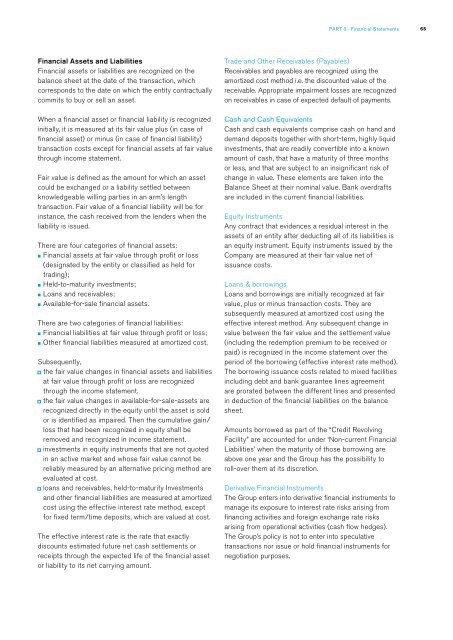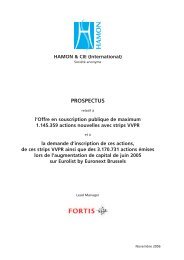Download PDF version English(2664KB) - Hamon
Download PDF version English(2664KB) - Hamon
Download PDF version English(2664KB) - Hamon
You also want an ePaper? Increase the reach of your titles
YUMPU automatically turns print PDFs into web optimized ePapers that Google loves.
Part 3 - Financial Statements<br />
65<br />
Financial Assets and Liabilities<br />
Financial assets or liabilities are recognized on the<br />
balance sheet at the date of the transaction, which<br />
corresponds to the date on which the entity contractually<br />
commits to buy or sell an asset.<br />
When a financial asset or financial liability is recognized<br />
initially, it is measured at its fair value plus (in case of<br />
financial asset) or minus (in case of financial liability)<br />
transaction costs except for financial assets at fair value<br />
through income statement.<br />
Fair value is defined as the amount for which an asset<br />
could be exchanged or a liability settled between<br />
knowledgeable willing parties in an arm’s length<br />
transaction. Fair value of a financial liability will be for<br />
instance, the cash received from the lenders when the<br />
liability is issued.<br />
There are four categories of financial assets:<br />
■ Financial assets at fair value through profit or loss<br />
(designated by the entity or classified as held for<br />
trading);<br />
■ Held-to-maturity investments;<br />
■ Loans and receivables;<br />
■ Available-for-sale financial assets.<br />
There are two categories of financial liabilities:<br />
■ Financial liabilities at fair value through profit or loss;<br />
■ Other financial liabilities measured at amortized cost.<br />
Subsequently,<br />
the fair value changes in financial assets and liabilities<br />
at fair value through profit or loss are recognized<br />
through the income statement.<br />
the fair value changes in available-for-sale-assets are<br />
recognized directly in the equity until the asset is sold<br />
or is identified as impaired. Then the cumulative gain/<br />
loss that had been recognized in equity shall be<br />
removed and recognized in income statement.<br />
investments in equity instruments that are not quoted<br />
in an active market and whose fair value cannot be<br />
reliably measured by an alternative pricing method are<br />
evaluated at cost.<br />
loans and receivables, held-to-maturity Investments<br />
and other financial liabilities are measured at amortized<br />
cost using the effective interest rate method, except<br />
for fixed term/time deposits, which are valued at cost.<br />
The effective interest rate is the rate that exactly<br />
discounts estimated future net cash settlements or<br />
receipts through the expected life of the financial asset<br />
or liability to its net carrying amount.<br />
Trade and Other Receivables (Payables)<br />
Receivables and payables are recognized using the<br />
amortized cost method i.e. the discounted value of the<br />
receivable. Appropriate impairment losses are recognized<br />
on receivables in case of expected default of payments.<br />
Cash and Cash Equivalents<br />
Cash and cash equivalents comprise cash on hand and<br />
demand deposits together with short-term, highly liquid<br />
investments, that are readily convertible into a known<br />
amount of cash, that have a maturity of three months<br />
or less, and that are subject to an insignificant risk of<br />
change in value. These elements are taken into the<br />
Balance Sheet at their nominal value. Bank overdrafts<br />
are included in the current financial liabilities.<br />
Equity Instruments<br />
Any contract that evidences a residual interest in the<br />
assets of an entity after deducting all of its liabilities is<br />
an equity instrument. Equity instruments issued by the<br />
Company are measured at their fair value net of<br />
issuance costs.<br />
Loans & borrowings<br />
Loans and borrowings are initially recognized at fair<br />
value, plus or minus transaction costs. They are<br />
subsequently measured at amortized cost using the<br />
effective interest method. Any subsequent change in<br />
value between the fair value and the settlement value<br />
(including the redemption premium to be received or<br />
paid) is recognized in the income statement over the<br />
period of the borrowing (effective interest rate method).<br />
The borrowing issuance costs related to mixed facilities<br />
including debt and bank guarantee lines agreement<br />
are prorated between the different lines and presented<br />
in deduction of the financial liabilities on the balance<br />
sheet.<br />
Amounts borrowed as part of the “Credit Revolving<br />
Facility” are accounted for under ‘Non-current Financial<br />
Liabilities’ when the maturity of those borrowing are<br />
above one year and the Group has the possibility to<br />
roll-over them at its discretion.<br />
Derivative Financial Instruments<br />
The Group enters into derivative financial instruments to<br />
manage its exposure to interest rate risks arising from<br />
financing activities and foreign exchange rate risks<br />
arising from operational activities (cash flow hedges).<br />
The Group’s policy is not to enter into speculative<br />
transactions nor issue or hold financial instruments for<br />
negotiation purposes.














